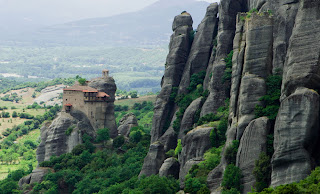There are so many beautiful monasteries around the world. But these six monasteries located in Greece that I am going to tell are the most unique ones. These monasteries are build on natural rock pillar on the edge of the Pindus Mountains in central Greece, these six spectacular Monasteries are known as “Monasteries of Meteora” means floating in the air.
1. The Monastery of St. Stephan
This monastery was founded in 14th century. Now its convent for nuns. It is located almost on the outskirts of Kalambaka, a bridge there makes it easy to get there.
This monastery was badly damaged in World War II and the afterwards in civil war. So many precious and priceless water color paintings on walls were erased and others were totally were destroyed. Fortunately the Monastery’s most sacred asset the head of St. Charlambos was saved, about that its famous it wards off the illness.
Recently the nuns have been attempting to restore the sections of the monastery that are declining.
This monastery has a small museum having collection of ecclesiastical robes and objects.
Most of all this monastery haves a fascinating view.
2. The Monastery of the Holy Trinity
The Holy Trinity Monastery looks familiar, it probably can be that you seen in James Bond movie For Your Eyes only.
Aside from that great honor, the Holy Trinity Monastery boasts one of the most spectacular positions of the six Meteora monasteries – Agia Triada is perched atop a slender pinnacle and accessible only by 140 steep steps.
The one monk who lives there welcomes visitors and shows them around the monastery’s church, refectory and courtyard. Visitors to Holy Trinity can also see the winch system used to bring people and supplies to the mountaintop monasteries.
3. The Holy Monastery of Great Meteoron
If you are not having time to visit all six monasteries of Meteora then visit only one Great Meteoron Monastery. Though other monasteries are worth visiting but this one is top on all.
The Great Meteoron Monastery was founded in the 14th century but monks built the present monastery in 16th century that visitors see now.
The lovely church at the Great Meteoron is in the shape of a Greek cross and topped by a 12-sided dome. Inside there are so many watercolor elaborated wall paintings.
The frescoes in the dome feature Christ, the four evangelists, the apostles, and the prophets. Church fathers are by the altar and liturgical feasts are depicted along the walls of the nave. The narthex is decorated with rather frightening images of the Last Judgment and Punishment of the Damned.
Outside the church is a pleasant shady courtyard and a small museum containing icons and illuminated manuscripts. The wine cellar is well stocked with barrels of the sacred drink.
4. The Monastery of Saint Nikolaos Anapafsas
The Monastery of Saint Nikolaos Anapafsas is a little 14th century monastery approached by a relatively gentle path on the otherwise rugged Meteora in Greece.
It features splendid frescoes by the 16th century Cretan painter Theophanes the Monk.
5. Roussanou Monastery
Roussanou Monastery is on top of the rocky peaks of Meteora in Thessaly, Greece. Standing tall and strong still yet centuries passed.
It was founded in the 13th century and now functions as a convent for nuns. The site includes octagonal domed church and beautiful courtyard. Its now easily accessible, thanks to its new bridge.
6. Varlaam Monastery
Varlaam Monastery is named for the monk who first built a tiny chapel on this rocky promontory in the 14th century.
In the 16th century two brothers from the monastery at loannina enlarged the chapel and founded the monastery. According to legend, they had to drive away the monster who lived in a cave on the summit before they could move in.
Today, a narrow bridge that runs from the main road on the Meteora can access Varlaam Monastery. Varlaam Monastery’s most pleasant features are the garden and the monk who sometimes sits there and chats with visitors. The old refectory is now a museum.
Varlaam contains frescoes by the well-known iconographer Frangos Katelanos and houses a collection of relics, carved wooden crosses, icons, embroidered epitaphoi and many other ecclesiastical treasures.
North of the church is the “Parekklesion of the Three” (dedicated to the Three Bishops: St. Basil the Great, St. Gregory the Theologian, and St. John Chrysostom), which was built in 1627 and decorated in 1637.
The busiest tourist season at Meteora is between May and September. The mountain range to the east and north of Meteora experiences baking heat in summer and severe cold in winter with heavy snowfalls. Summer is the driest time. Storms occur year round, especially at higher altitudes. Most visitors to Meteora stay in Kalambaka or Kastraki, the two closest villages to Meteora.
In my opinion these Monasteries are the standing human hand build wonders of world still standing tall having so many stories along them. A sacred but fascinating place to visit.














